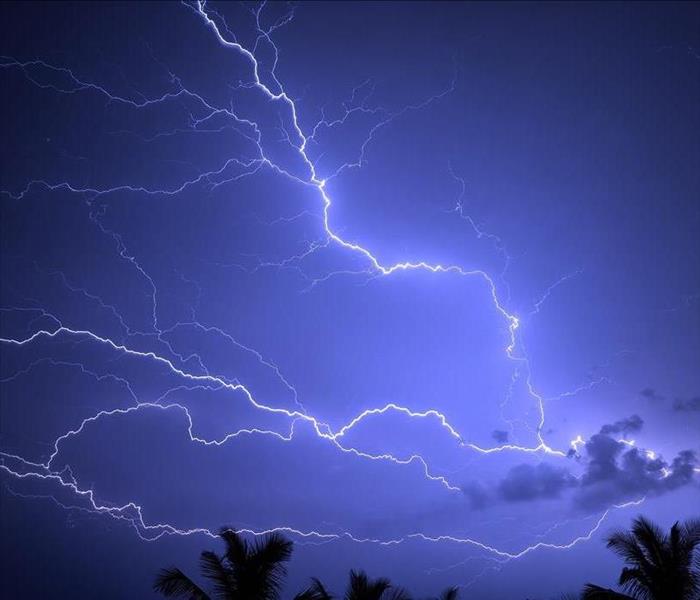3 Types of Lightning in a Storm
9/23/2022 (Permalink)
Nearly every storm event presents lightning and, with it, serious concerns for human safety. All the while, lightning also poses risks to residential and commercial properties. Hurricanes, which we do not often consider to be storms capable of producing lightning, do sometimes have lightning near the eye of the storm. During a thunderstorm, there are 3 common types of lightning you may see. Becoming familiar with these 3 different types is an important part of storm safety. Today’s blog will explain the 3 common types using information from NOAA’s “Lightning Types” article, but we will also discuss safety risks associated with each lightning type so that you can be informed, which is the best way to protect yourself and your home or business from lightning dangers.
Cloud-to-Ground Lightning
Cloud-to-ground lighting is the most dangerous type of lightning for properties. This type of lightning occurs when a channel of negative charge shooting down from a storm cloud meets a positive charge from tall objects like nearby trees, power lines, and tall structures like homes and commercial buildings. In the event that the positive charge comes from a tall property, the unification of the positive and negative charges causes an electrical current to start flowing, posing safety risks to properties and people inside of them if a fire ignites as a result of an electrical surge. To prevent damage from a lightning strike, it is best to protect your property with surge protectors. If a thunderstorm is in your area, even if you don’t see lightning, it is beneficial to step away from electrical appliances and avoid activities involving water, such as taking a shower or washing dishes.
Cloud Flashes
From time to time, lightning never reaches the ground. When you see flashes of light in the clouds but no lightning bolts, what you are observing is known as cloud flashes. In cloud flashes, the lightning usually remains in the clouds through what NOAA calls “intra-cloud lightning flashes.” According to The National Weather Service, “an electrical discharge between oppositely charged areas within the thunderstorm cloud” causes cloud flashes. Even though we know that cloud-to-ground lightning is a more dangerous type of lightning, cloud flashes still pose safety threats, as they indicate that the storm is producing lightning, so cloud-to-ground lightning could develop at any time.
Heat Lightning
It may come as a surprise to learn that there is no such thing as heat lightning. So why are we including it in this blog? The National Weather Service states that if you see cloud flashes without thunder (what we normally call “heat lightning”), what you see is actually faint lightning flashes from a thunderstorm just far enough away that your eyes can’t see the cloud-to-ground lightning it is generating or hear the thunder that accompanies it.
Experience Lightning Damage? Call SERVPRO
If lightning from a storm causes damage to your property, call SERVPRO Team Wall as soon as possible for fast, 24-hour service that will restore your home or business to its preloss condition. With top-of-the-line resources and professional, experienced storm damage restoration specialists, we specialize in making your property damage “like it never even happened” after any storm. At the first sign of damage, pick up the phone and call SERVPRO of Harrisburg West at (717) 510-6779 to speak with one of our team members. Be sure to also check out our website for more information about our Storm Damage Restoration capabilities, including storm restoration services tailored specifically to commercial properties, our Disaster Recovery Team for large losses, and our water restoration process.





 24/7 Emergency Service
24/7 Emergency Service
